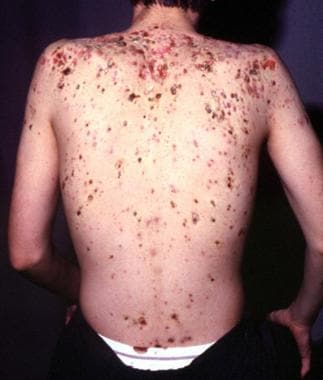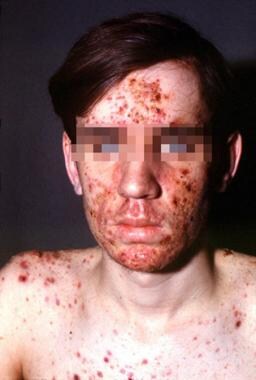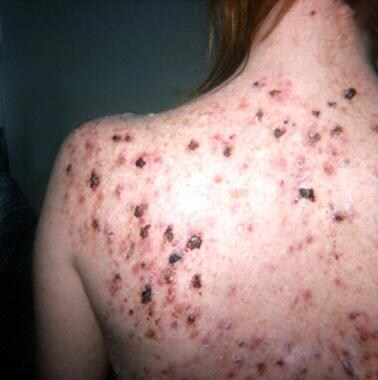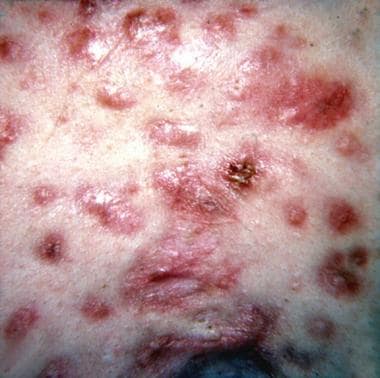Practice Essentials
Acne conglobata is an uncommon and unusually severe form of acne characterized by burrowing and interconnecting abscesses and irregular scars (both keloidal and atrophic), often producing pronounced disfigurement. The comedones often occur in groups of two or three, and cysts contain foul-smelling seropurulent material that returns after drainage. The nodules are usually found on the chest, shoulders, back, buttocks, upper arms, thighs, and face. [1] (See the images below.) Acne conglobata may develop as a result of a sudden deterioration of existing active papular or pustular acne, or it may occur as the recrudescence of acne that has been quiescent for many years.
Acne conglobata may occur as a component of the follicular occlusion triad, together with hidradenitis suppurativa and perifolliculitis capitis abscedens et suffodiens. [2, 3, 4] .
Pyogenic arthritis, pyoderma gangrenosum, and acne conglobata are clinically distinct inflammatory disorders that in rare case may be seen in the same patient in a syndrome known as PAPA syndrome. This was originally reported in a three-generation kindred with autosomal dominant transmission. The PAPA syndrome is related to the triad of pyoderma gangrenosum, acne conglobata, and suppurative hidradenitis, known as the PASH syndrome. [5]
The simultaneous presence of pyoderma gangrenosum, acne conglobata, suppurative hidradenitis, and seronegative spondyloarthritis has been suggested as a new linkage, designated as PASS syndrome. [6]
Micali and Lacarrubba adroitly observed that secondary comedones in acne conglobata may correlate with double-ended pseudocomedones in hidradenitis suppurativa. [7] In one series of 1094 pediatric patients with hidradenitis suppurativa, 503 (45.9%) had acne conglobata. [8]
Acne conglobata may also be associated with the SAPHO (synovitis, acne conglobata, pustulosis, hyperostosis, osteitis) syndrome. SAPHO syndrome is characterized by distinctive osteoarticular manifestations and a spectrum of neutrophilic dermatoses, including palmoplantar pustulosis. [9] It should be considered in patients with osteoarticular pain, particularly pain involving the anterior chest wall and/or spine, and neutrophilic skin lesions.
Acne conglobata may also be associated with the rare autoinflammatory bone disease chronic nonbacterial osteomyelitis. [10]
The therapy of choice for acne conglobata includes isotretinoin 0.5-1 mg/kg for 4-6 months. Simultaneous systemic steroid therapy (eg, prednisone 1 mg/kg/day for 2-4 wk), may also prove beneficial, particularly if systemic symptoms are evident.
Other acne-related Medscape articles include Acne Fulminans, Acne Keloidalis Nuchae, Acne Vulgaris, and Acneiform Eruptions.
Pathophysiology
The primary causes of acne conglobata remain unknown. Chromosomal defects in the XYY karyotype may be responsible for severe forms of acne conglobata. In contrast, the XXY karyotype of Klinefelter syndrome is believed to exclude severe acne; however, 1 patient with the unusual combination of Klinefelter syndrome and acne conglobata has been reported. [11]
The association of this disease with specific human leukocyte antigen (HLA) phenotypes has not been proven. The HLA-A and HLA-B phenotypes were evaluated in 65 patients with acne conglobata, in whom antigen frequencies were found to be normal. Other patients with acne conglobata and hidradenitis suppurativa were studied; 4 of 6 patients had HLA-B7 cross-reacting antigens (ie, HLA-B7, HLA-Bw22, HLA-B27, HLA-Bw40, HLA-Bw42), and all had HLA-DRw4. [12]
PAPA syndrome has been mapped to a locus on the long arm of chromosome 15 (maximum 2-point logarithm of odds score 5.83; recombination fraction [straight theta] 0 at locus D15S206). [13] Assuming complete penetrance, haplotype analysis of recombination events defined an interval of 10 centimorgans between loci D15S1023 and D15S979. This finding suggests that these clinically distinct disorders may share a genetic etiology.
Etiology
The primary cause of acne conglobata remains unknown.
Changes in reactivity to Cutibacterium acnes (formerly Propionibacterium acnes) may play an important role in the etiology of the disease.
Exposure to halogenated aromatic hydrocarbons (eg, dioxins) or ingestion of halogens (eg, thyroid medication, hypnotic agents) may trigger acne conglobata in an individual who is predisposed.
Other factors that can provoke acne conglobata include androgens (eg, androgen-producing tumors) and anabolic steroids.
Acne conglobata and acne fulminans may appear after cessation of testosterone therapy or as a reaction to other medications. [14]
Childhood obesity appears to enhance the risk of the development of early-onset follicular occlusion triad, of which acne conglobata is a component. [2]
Epidemiology
Acne conglobata is an uncommon disease, and the disease affects males more frequently than females.
The onset of acne conglobata usually occurs in young adults aged 18-30 years, but infants may develop this condition as well.
Prognosis
Acne conglobata can produce pronounced disfigurement. Severe scarring produces psychological impairment; individuals with acne conglobata are often ostracized, or they may feel excluded. Acne conglobata has also been responsible for anxiety and depression in many patients.
-
Nodules on back. Image from Emanuel G Kuflik.
-
Nodules on face. Image from Emanuel G Kuflik.
-
Closer view of nodules and pustules on back. Image from Emanuel G Kuflik.
-
Close-up view of nodules and pustules on forehead. Image from Emanuel G Kuflik.
-
Nodules and pustules on back. Image from Emanuel G Kuflik.
-
Close-up view of nodules and pustules on back. Image from Emanuel G Kuflik.





